Holographic Grating Enhancement Induced by a Dual-Photo-Initiator System in PMMA Substrate Polymers
Abstract
:1. Introduction
2. Materials and Methods
3. Results and Discussion
3.1. Dual-Photo-Initiator Doping NPDD Model
3.2. Experimental Investigations of Holographic Performances in TI&EY/PMMA Polymers
4. Conclusions
Author Contributions
Funding
Institutional Review Board Statement
Data Availability Statement
Conflicts of Interest
References
- Zhang, D.; Lu, J.; Pei, C.; Ni, S. Electrochemical activation, sintering, and reconstruction in energy-storage technologies: Origin, development, and prospects. Adv. Energy. Mater. 2022, 12, 2103689. [Google Scholar] [CrossRef]
- Li, X.; Zhang, L.; Liu, H.; Li, Q.; Hou, Y. Magnetic Measurements Applied to Energy Storage. Adv. Energy. Mater. 2023, 13, 2300927. [Google Scholar] [CrossRef]
- Kim, S.S.; Yong, S.K.; Kim, W.; Kang, S.; Park, H.W.; Yoon, K.J.; Hwang, C.S. Review of semiconductor flash memory devices for material and process issues. Adv. Mater. 2023, 35, 2200659. [Google Scholar] [CrossRef] [PubMed]
- Hu, P.; Li, J.; Jin, J.; Lin, X.; Tan, X. Highly sensitive photopolymer for holographic data storage containing methacryl polyhedral oligomeric silsesquioxane. ACS Appl. Mater. Inter. 2022, 14, 21544–21554. [Google Scholar] [CrossRef] [PubMed]
- Liu, P.; Sun, X. Theoretical and Experimental Investigations of Diffraction Characteristics Influenced by Holographic Reciprocity Effect in PQ/PMMA Polymers. Polymers 2023, 15, 1486. [Google Scholar] [CrossRef] [PubMed]
- Liu, Y.; Shen, T.; Kang, B.; Li, S.; Zheng, Z.; Lv, H.; Zheng, J. Enhancement of holographic performance and stability of photopolymer materials by introducing epoxy resin and dyes. Opt. Laser. Tech. 2022, 156, 108580. [Google Scholar] [CrossRef]
- Wang, J.; Tan, X.; Qi, P.; Wu, C.; Huang, L.; Xu, X.; Kuroda, K. Linear polarization holography. Opto-Electron. Sci. 2022, 1, 210009. [Google Scholar] [CrossRef]
- Shujun, Z.; Xiao, L.; Zhiyun, H.; Lu, H.; Yuanying, Z.; Yi, Y.; Xiaodi, T. Light field regulation based on polarization holography. Opto-Electron. Eng. 2022, 49, 220114. [Google Scholar]
- Li, J.; Hu, P.; Jin, J.; Wang, J.; Liu, J.; Wu, J.; Tan, X. Highly sensitive photopolymer for holographic data storage. Opt. Express 2022, 30, 40599–40610. [Google Scholar] [CrossRef]
- Wang, J.; Pei, Y.; Shi, H.; Gao, B.; Luo, S. High-density and high-quality holographic storage in a multilayer glass-like photopolymer. Opt. Mater. Express 2022, 12, 845–853. [Google Scholar] [CrossRef]
- Lisa, D.H.A.R. Holographic data storage: Coming of age. Nat. Photonics 2008, 2, 403–405. [Google Scholar]
- Burr, G.W.; Jefferson, C.M.; Coufal, H.; Jurich, M.; Hoffnagle, J.A.; Macfarlane, R.M.; Shelby, R.M. Volume holographic data storage at an areal density of 250 gigapixels/in. 2. Opt. Lett. 2001, 26, 444–446. [Google Scholar] [CrossRef] [PubMed]
- Heanue, J.F.; Bashaw, M.C.; Hesselink, L. Volume holographic storage and retrieval of digital data. Science 1994, 265, 749–752. [Google Scholar] [CrossRef] [PubMed]
- Hesselink, L.; Orlov, S.S.; Liu, A.; Akella, A.; Lande, D.; Neurgaonkar, R.R. Photorefractive materials for nonvolatile volume holographic data storage. Science 1998, 282, 1089–1094. [Google Scholar] [CrossRef] [PubMed]
- Bruder, F.K.; Hagen, R.; Rölle, T.; Weiser, M.S.; Fäcke, T. From the surface to volume: Concepts for the next generation of optical–holographic data-storage materials. Angew. Chem. Int. Ed. 2011, 50, 4552–4573. [Google Scholar] [CrossRef]
- Cao, L.; Wang, Z.; Zhang, H.; Guo, J.; Gu, C. Volume holographic printing using unconventional angular multiplexing for three-dimensional display. Appl. Opt. 2016, 55, 6046–6051. [Google Scholar] [CrossRef]
- Zhao, Y.; Li, Z.; Luo, Z.; Jun, L.; Zhong, J.; Ye, Y.; Zhu, J. Particle field diagnose using angular multiplexing volume holography. In Proceedings of the Optics and Photonics for Information Processing XI, San Diego, CA, USA, 7–8 August 2017; Volume 10395, pp. 42–47. [Google Scholar]
- Cody, D.; Gul, S.E.; Mikulchyk, T.; Irfan, M.; Kharchenko, A.; Goldyn, K.; Naydenova, I. Self-processing photopolymer materials for versatile design and fabrication of holographic sensors and interactive holograms. Appl. Opt. 2018, 57, E173–E183. [Google Scholar] [CrossRef]
- Wang, J.; Luo, S. Volume holographic storage using sync-angular multiplexing by rotating material in thick photopolymer. Opt. Laser Tech. 2022, 153, 108295. [Google Scholar] [CrossRef]
- Wang, J.; Fu, Q.; Zhang, Y.; Zhang, B. Holographic Properties of Irgacure 784/PMMA Photopolymer Doped with SiO2 Nanoparticles. Polymers 2023, 15, 4391. [Google Scholar] [CrossRef]
- Guo, B.; Wang, M.; Zhang, D.; Sun, M.; Bi, Y.; Zhao, Y. High Refractive Index Monomers for Improving the Holographic Recording Performance of Two-Stage Photopolymers. ACS Appl. Mater. Inter. 2023, 15, 24827–24835. [Google Scholar] [CrossRef]
- Kim, K.; Lim, Y.; Son, H.; Hong, S.J.; Shin, C.W.; Baek, D.; Lee, S. Optical Fourier Volumes: A Revisiting of Holographic Photopolymers and Photoaddressable Polymers. Adv. Opt. Mater. 2022, 10, 2201421. [Google Scholar] [CrossRef]
- Mihaylova, E.M. Water-Soluble Holographic Photopolymers for a Sustainable Future—A Review. Coatings 2022, 12, 1765. [Google Scholar] [CrossRef]
- Liu, Y.; Fan, F.; Tan, X. SiO2 NPs-PQ/PMMA Photopolymer material doped with a high-concentration photosensitizer for holographic storage. Polymers 2020, 1, 816. [Google Scholar] [CrossRef] [PubMed]
- Yu, D.; Liu, H.; Jiang, Y.; Sun, X. Holographic storage stability in PQ-PMMA bulk photopolymer. Opt. Commun. 2010, 283, 4219–4223. [Google Scholar] [CrossRef]
- Wang, H.; Wang, J.; Liu, H.; Yu, D.; Sun, X.; Zhang, J. Study of effective optical thickness in photopolymer for application. Opt. Lett. 2012, 37, 2241–2243. [Google Scholar] [CrossRef] [PubMed]
- Zeng, Z.; Hu, P.; Hao, J.; Jin, J.; Li, J.; Liu, J.; Lin, X. The effect of PQ concentration on holographic data storage in PQ/PMMA material. In Proceedings of the Ultra-High-Definition Imaging Systems VI SPIE, San Francisco, CA, USA, 1–2 February 2023; Volume 12444, pp. 37–41. [Google Scholar]
- Liu, P.; Sun, X.; Wang, L. Polarization holographic characteristics of TI/PMMA polymers by linearly polarized exposure. Opt. Mater. 2020, 107, 109992. [Google Scholar] [CrossRef]
- Conde-Cuatzo, M.G.; Olivares-Pérez, A.; Toxqui-López, S.; Fuentes-Tapia, I.; Ambrosio-González, M.A. Real-time holographic gratings recorded in Norland Optical Adhesive 65 and yellow eosin. In Proceedings of the Practical Holography XXXIV: Displays, Materials, and Applications, San Francisco, CA, USA, 1–6 February 2020; SPIE: Bellingham, WA, USA; Volume 11306, pp. 141–147. [Google Scholar]
- Liu, P.; Wang, L.; Zhao, Y.; Li, Z.; Sun, X. Holographic memory performances of titanocene dispersed poly (methyl methacrylate) photopolymer with different preparation conditions. Opt. Mater. Express 2018, 8, 1441–1453. [Google Scholar] [CrossRef]
- Lin, S.H.; Hsiao, Y.N.; Hsu, K.Y. Preparation and characterization of Irgacure 784 doped photopolymers for holographic data storage at 532 nm. J. Opt. A Pure Appl. Opt. 2009, 11, 024012. [Google Scholar] [CrossRef]
- Liu, Y.; Fan, F.; Hong, Y.; Zang, J.; Kang, G.; Tan, X.; Shimura, T. Volume holographic recording in Al nanoparticles dispersed phenanthrenequinone-doped poly (methyl methacrylate) photopolymer. Nanotechnology 2019, 30, 145202. [Google Scholar] [CrossRef]
- Srivastava, V.; Singh, P.P. Eosin Y catalysed photoredox synthesis: A review. RSC Adv. 2017, 7, 31377–31392. [Google Scholar] [CrossRef]
- Kogelnik, H. Coupled wave theory for thick hologram gratings. Bell Sys. Tech. J. 1969, 48, 2909–2947. [Google Scholar] [CrossRef]
- Yu, D.; Liu, H.; Geng, Y.; Wang, W.; Zhao, Y. Radical polymerization in holographic grating formation in PQ-PMMA photopolymer part I: Short exposure. Opt. Commun. 2014, 330, 191–198. [Google Scholar] [CrossRef]
- Yu, D.; Liu, H.; Geng, Y.; Wang, W.; Zhao, Y. Radical polymerization in holographic grating formation in PQ-PMMA photopolymer part I: Part II: Consecutive exposure and dark decay. Opt. Commun. 2014, 330, 199–207. [Google Scholar] [CrossRef]
- Malallah, R.E.; Li, H.; Qi, Y.; Cassidy, D.; Muniraj, I.; Al-Attar, N.; Sheridan, J.T. Improving the uniformity of holographic recording using multi-layer photopolymer: Part II. Experimental results. J. Opt. Soc. Am. A 2019, 36, 334–344. [Google Scholar] [CrossRef] [PubMed]
- Liu, Y.; Li, Z.; Zang, J.; Wu, A.A.; Wang, J.; Lin, X.; Kuroda, K. The optical polarization properties of phenanthrenequinone-doped poly (methyl methacrylate) photopolymer materials for volume holographic storage. Opt. Rev. 2015, 22, 837–840. [Google Scholar] [CrossRef]
- Yu, D.; Liu, H.; Jiang, Y.; Sun, X. Mutual diffusion dynamics with nonlocal response in SiO2 nanoparticles dispersed PQ-PMMA bulk photopolymer. Opt. Express 2011, 19, 13787–13792. [Google Scholar] [CrossRef]
- Liu, P.; Wang, L.; Zhao, Y.; Li, Z.; Sun, X. Cationic photo-initiator titanocene dispersed PMMA photopolymers for holographic memories. OSA Continuum 2018, 1, 783–795. [Google Scholar] [CrossRef]
- Liu, Y.; Fan, F.; Hong, Y.; Zang, J.; Kang, G.; Tan, X. Volume holographic recording in Irgacure 784-doped PMMA photopolymer. Opt. Express 2017, 25, 20654–20662. [Google Scholar] [CrossRef]
- Li, Y.; Yang, Q.; Xiong, J.; Yin, K.; Wu, S.T. 3D displays in augmented and virtual realities with holographic optical elements. Opt. Express 2021, 29, 42696–42712. [Google Scholar] [CrossRef]
- Lucchetta, D.E.; Di Donato, A.; Francescangeli, O.; Singh, G.; Castagna, R. Light-controlled direction of distributed feedback laser emission by photo-mobile polymer films. Nanomaterials 2022, 12, 2890. [Google Scholar] [CrossRef]
- Jiang, N.; Davies, S.; Jiao, Y.; Blyth, J.; Butt, H.; Montelongo, Y.; Yetisen, A.K. Doubly photopolymerized holographic sensors. ACS Sens. 2021, 6, 915–924. [Google Scholar] [CrossRef] [PubMed]
- Voorsluys, W.; Broberg, J.; Buyya, R. Introduction to cloud computing. In Cloud Computing: Principles and Paradigms; John Wiley & Sons: Hoboken, NJ, USA, 2011; pp. 1–41. [Google Scholar]
- LeCun, Y.; Bengio, Y.; Hinton, G. Deep learning. Nature 2015, 521, 436–444. [Google Scholar] [CrossRef] [PubMed]
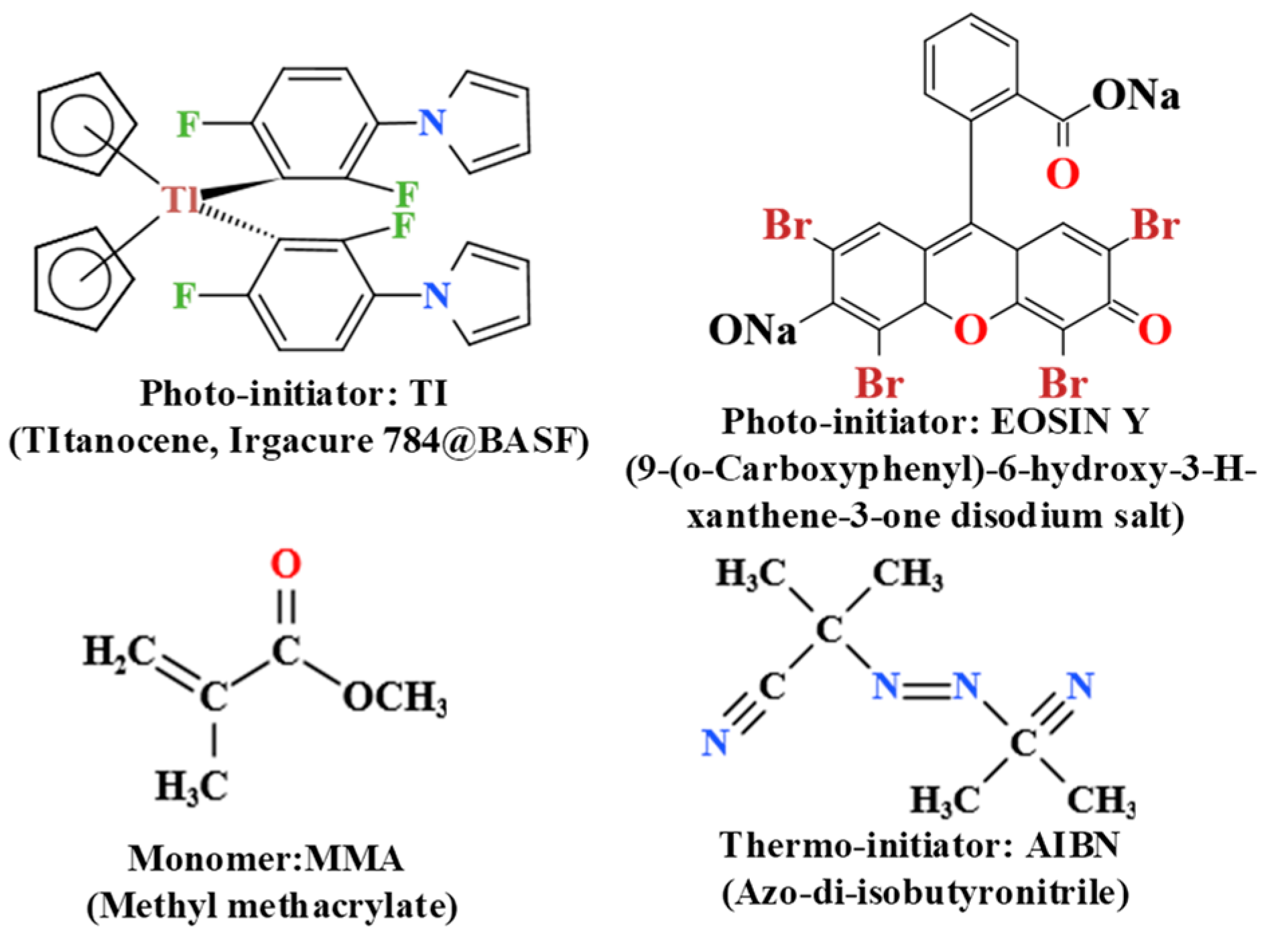

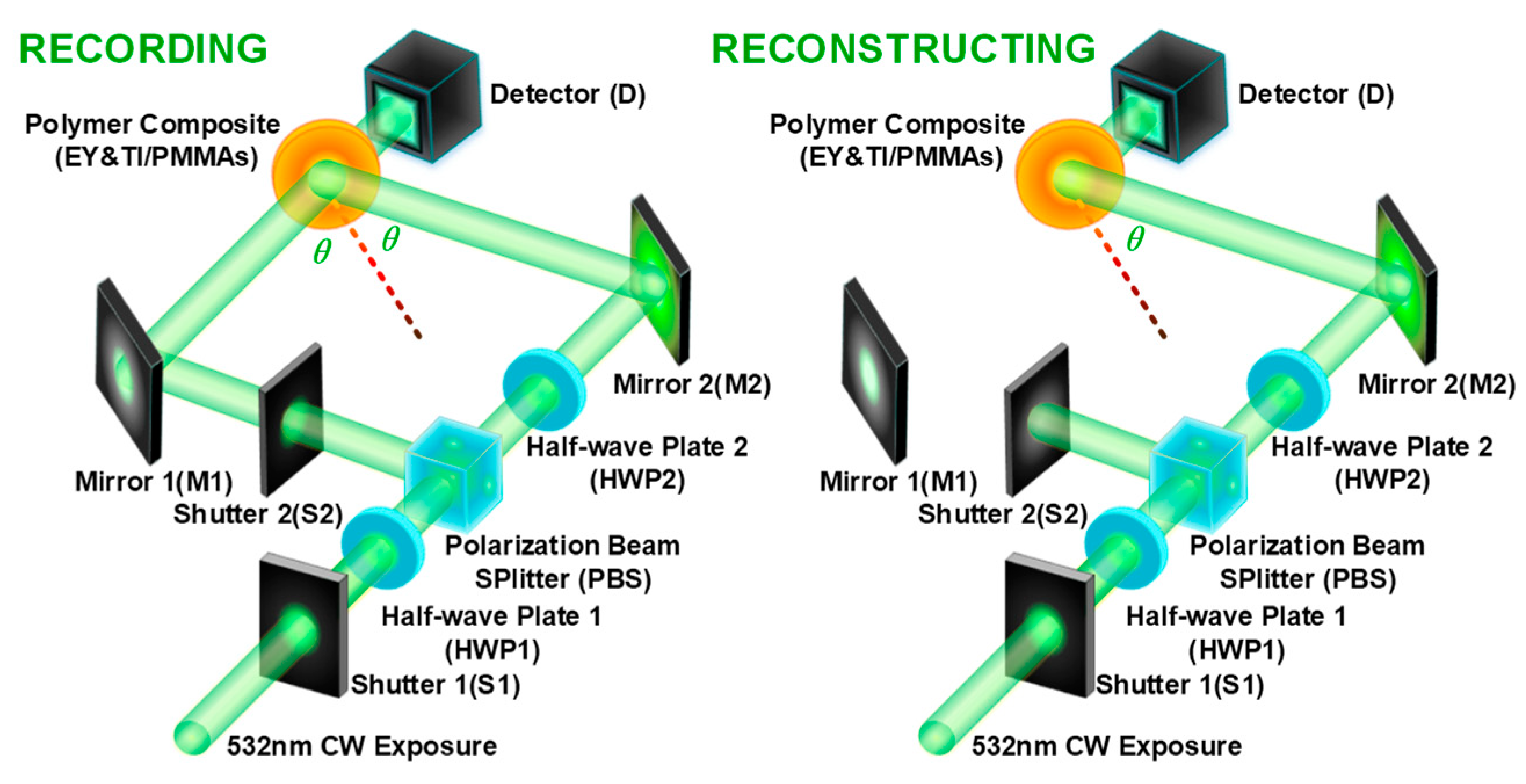

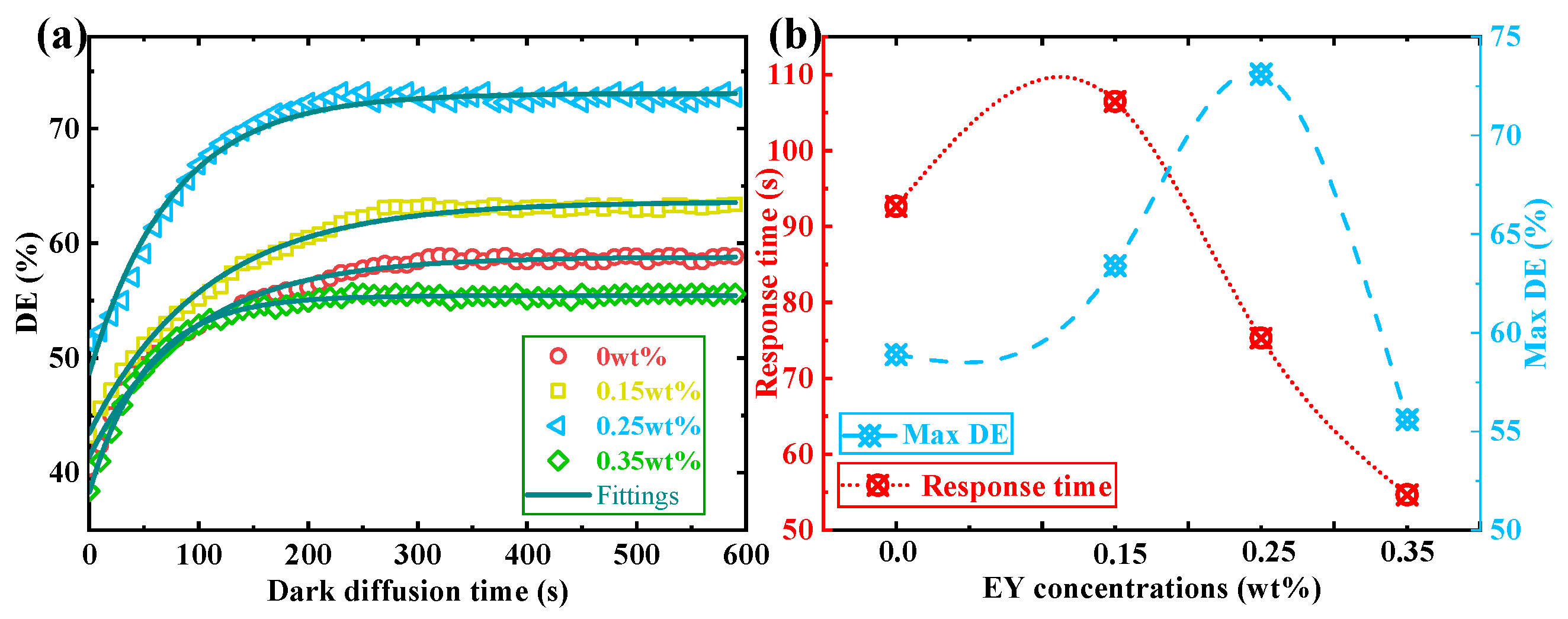
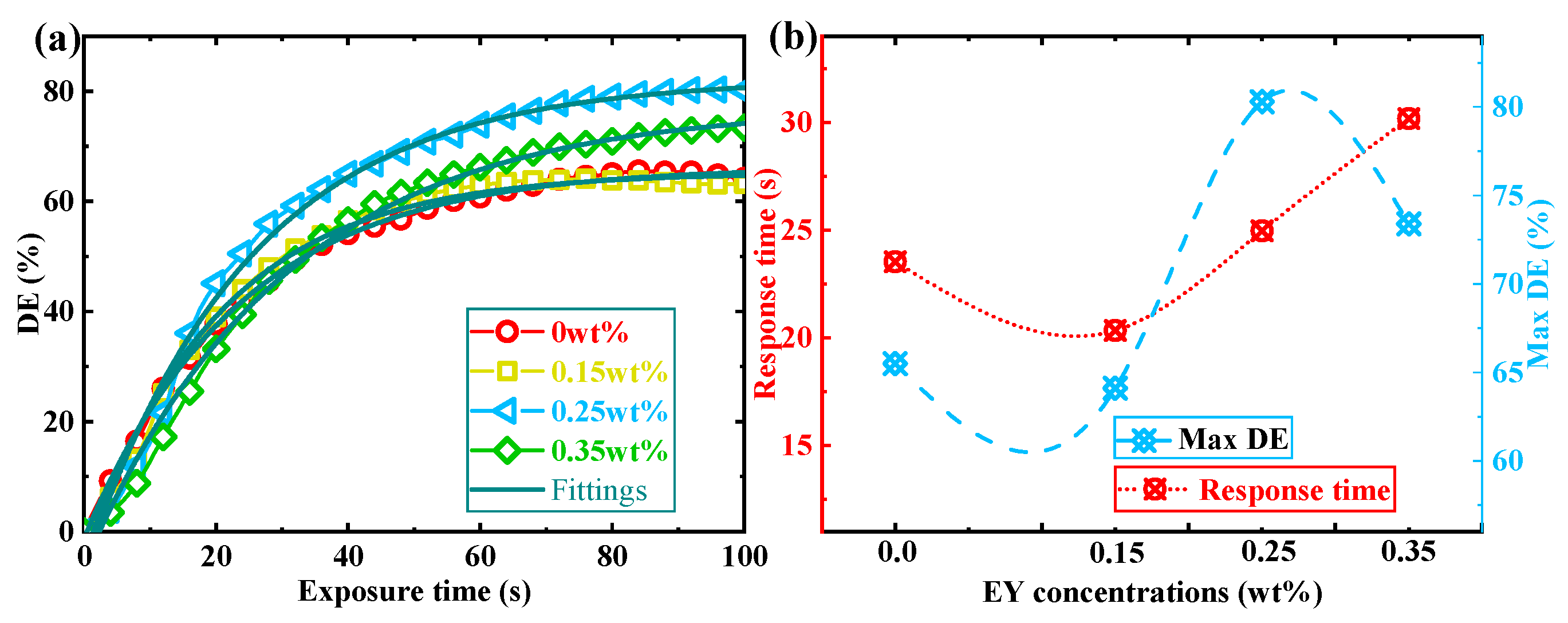
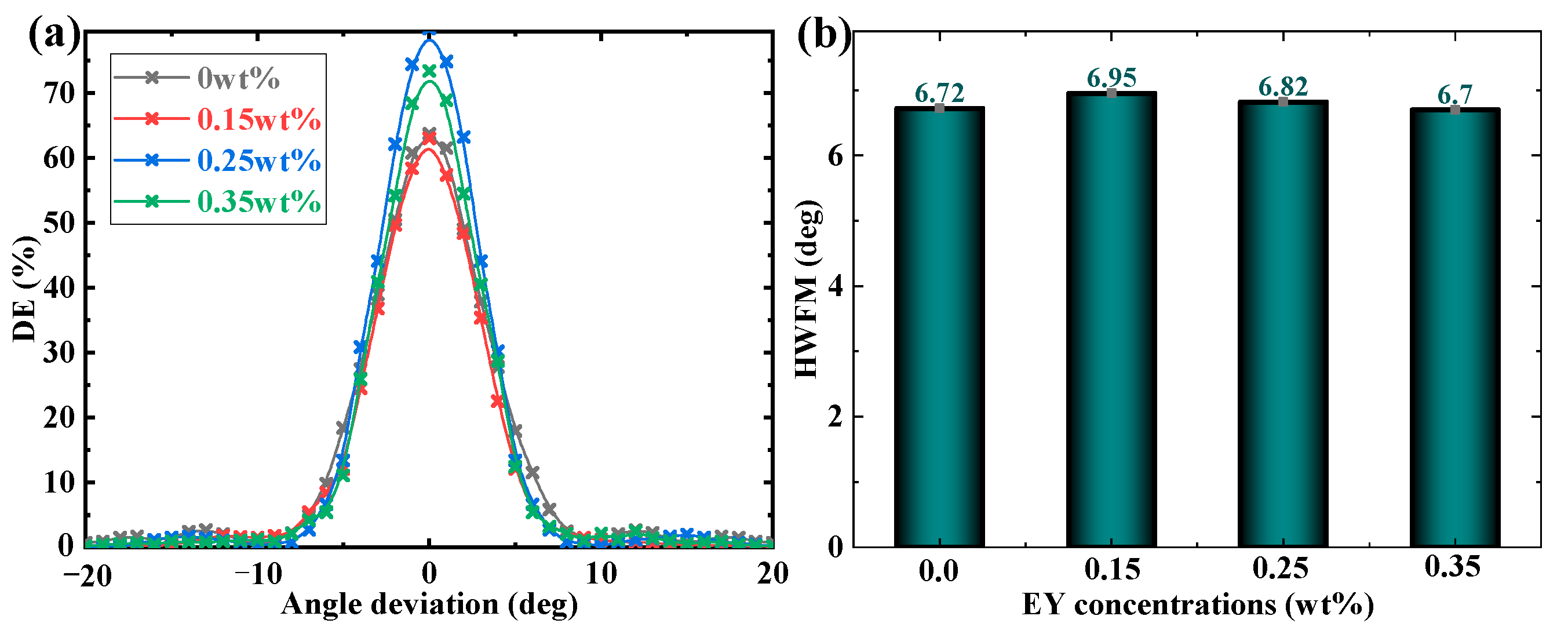
Disclaimer/Publisher’s Note: The statements, opinions and data contained in all publications are solely those of the individual author(s) and contributor(s) and not of MDPI and/or the editor(s). MDPI and/or the editor(s) disclaim responsibility for any injury to people or property resulting from any ideas, methods, instructions or products referred to in the content. |
© 2023 by the authors. Licensee MDPI, Basel, Switzerland. This article is an open access article distributed under the terms and conditions of the Creative Commons Attribution (CC BY) license (https://creativecommons.org/licenses/by/4.0/).
Share and Cite
Wang, P.; Sun, X.; Liu, P. Holographic Grating Enhancement Induced by a Dual-Photo-Initiator System in PMMA Substrate Polymers. Polymers 2024, 16, 126. https://doi.org/10.3390/polym16010126
Wang P, Sun X, Liu P. Holographic Grating Enhancement Induced by a Dual-Photo-Initiator System in PMMA Substrate Polymers. Polymers. 2024; 16(1):126. https://doi.org/10.3390/polym16010126
Chicago/Turabian StyleWang, Peiyao, Xiudong Sun, and Peng Liu. 2024. "Holographic Grating Enhancement Induced by a Dual-Photo-Initiator System in PMMA Substrate Polymers" Polymers 16, no. 1: 126. https://doi.org/10.3390/polym16010126
APA StyleWang, P., Sun, X., & Liu, P. (2024). Holographic Grating Enhancement Induced by a Dual-Photo-Initiator System in PMMA Substrate Polymers. Polymers, 16(1), 126. https://doi.org/10.3390/polym16010126






